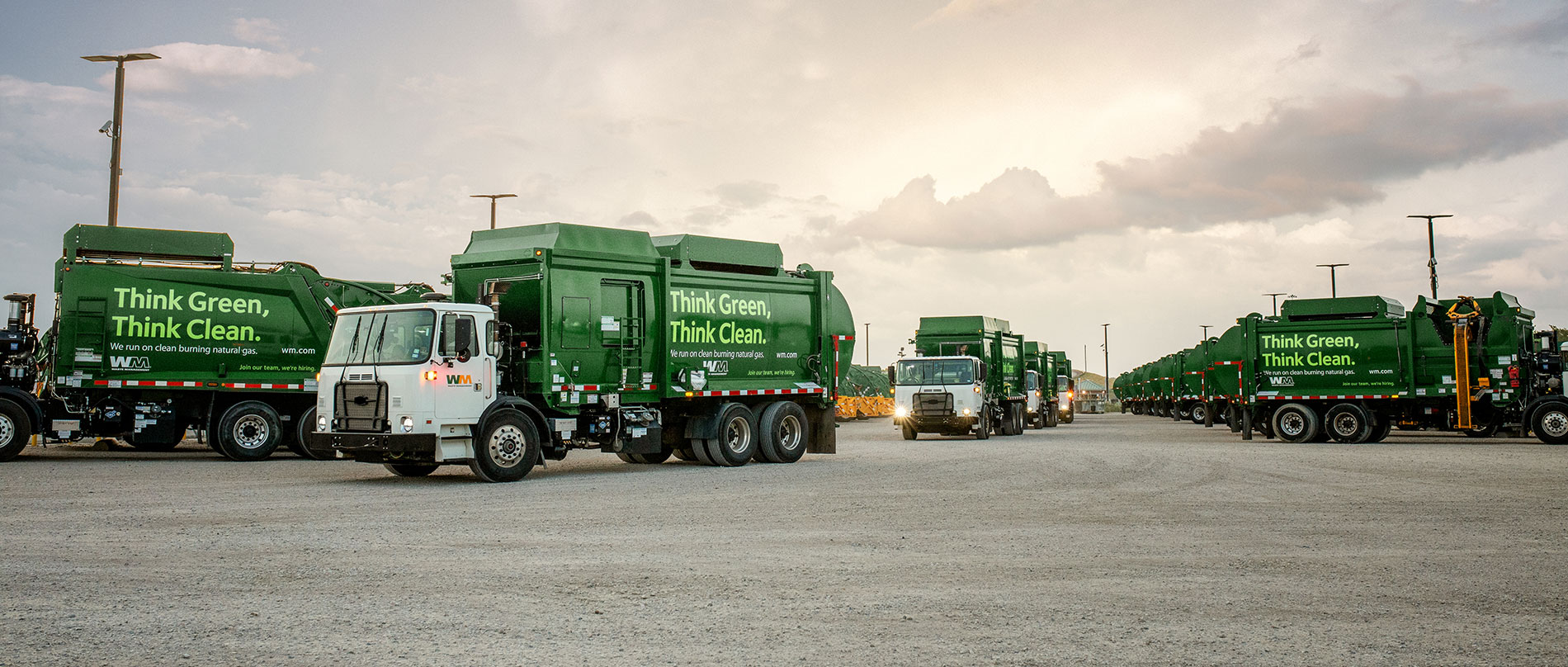
- Sustainability A-Z
- Fleet
Fleet
Our fleet connects customers with our services. As an essential component of our business, we strive to make our fleet as efficient, reliable and safe as possible.
Reducing Our Fleet Emissions
For decades, WM has invested in vehicles and infrastructure to transition our traditionally diesel fleet to lower-emission natural gas. According to the U.S. Environmental Protection Agency (EPA), natural gas vehicles can reduce tailpipe greenhouse gas (GHG) emissions by 20% and emit up to 90% less nitrogen oxide (NOx) than traditional diesel vehicles. Therefore, not only do natural gas vehicles avoid the use of millions of gallons of diesel fuel each year, but they also reduce our GHG emissions, are quieter than diesel trucks and emit nearly zero particulate emissions, which can help improve air quality.
As we continue to convert our fleet to natural gas vehicles, we are also investing in infrastructure and technology to support fueling our fleet. At many WM landfills, we capture, collect and treat landfill gas, so it can be converted into a renewable energy source that can be used to help power communities and businesses or allocated to our fleet. We also continue to invest in and expand our portfolio of fueling stations. In some cases, a fueling station is installed directly adjacent to where landfill gas is captured and processed, creating a closed loop through waste collection, conversion into energy and use as fuel for collection trucks. At locations where a pipeline-supplied natural gas fueling station would not be feasible, we have implemented an innovative hub-and-spoke fueling process to maximize the reach of our fueling stations. This allows the transfer of large amounts of compressed natural gas from an existing ‘hub’ fueling site via bulk trucking to various ‘spoke’ locations.
WM procures additional renewable natural gas (RNG) captured from dairy and hog operations to further increase renewable fuel use within our fleet. Converting waste manure to RNG is a win-win: it reduces methane emissions at a dairy farm and reduces vehicle emissions from trucks on the road. WM is also developing efforts to use biodiesel where compressed natural gas fuel is not available or practical, allowing us to further reduce our fossil fuel-derived diesel use.
Improving the Efficiency of Our Fleet
Beyond using lower-emission fuel, we are decreasing the amount of fuel we consume via logistics solutions, including route optimization technology that allows us to reach customers while traveling the shortest possible distance. Efficient routing translates to reduced fuel consumption and associated emissions, while also improving the quality of our service by limiting delays.
Our collection fleet also leverages DriveCam® technology, a video recorder mounted on the windshield of collection vehicles that is automatically activated by sudden movements. Where appropriate, managers watch videos with drivers to coach them on safer and more fuel-efficient driving techniques, such as proper acceleration, deceleration and efficient speeds.
We also use an anti-idling program to reduce fuel consumption. Through this program, all collection vehicles built after 1998 can program idle shutdown timers to five minutes, in accordance with the American Transportation Research Institute’s Compendium of Idling Regulations.
Piloting Alternative Technologies
While natural gas vehicles and the allocation of RNG to our collection vehicles have helped us significantly reduce fleet emissions, we continue to look for ways to further reduce our impact. For example, we pilot emerging technologies such as electric and hydrogen-powered vehicles. However, while electric cars are becoming more commonplace as passenger vehicles, significant challenges remain to operationalize heavy-duty electric vehicles. Current options for heavy-duty electric vehicles lack sufficient range, hauling capacity and proven experience for our operations. In addition, charging infrastructure is not yet widely available. Despite these challenges, we have an eye on the future. WM continues to test these and other vehicles to help us find new ways to reduce our carbon footprint, meet regulatory requirements and continue to provide customers with reliable service.
WM works with major domestic and international vehicle equipment manufacturers to identify lower-emission, state-of-the-art truck and compaction technologies for our fleet. We began operating our first electric-powered collection truck in 2020 in Southern California and are continuing to expand pilots of vehicles and programs throughout the United States. Beyond these initial vehicles, we continue testing alternative energy collection and support vehicles from nearly every major manufacturer, working with them to provide feedback on truck performance. By experimenting with a broad range of solutions, we expect to find the technologies that allow us to be successful and ultimately operate with zero emissions in the communities we serve.